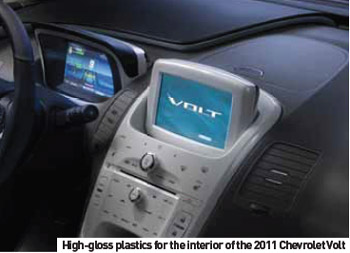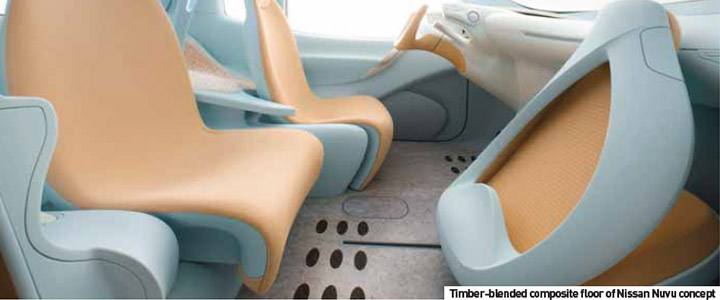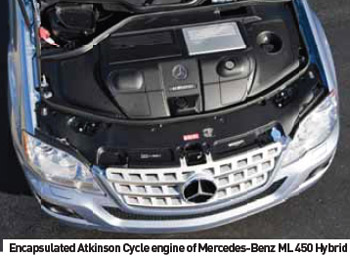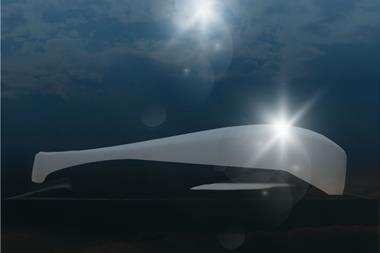Almost a year since the financial crisis began, Tier suppliers continue to face major challenges in key markets. Against that backdrop, a temptation to drastically cut R&D investment is understandable. But not every market has collapsed. Some, including Germany and China, have seen big year-on-year sales gains, thanks to government-led new car incentive programmes. As a result, some suppliers are experiencing increased demand for powertrain, plastics and automotive glass products.
Plastics offer a clear alternative
Before 2008 sales started to plunge in North America and Europe, Standard & Poor had valued the annual automotive glass market at approximately $3.5 billion. So far, 2009 has proven a difficult year for major players fighting for a share of a crowded market, including NSG-Pilkington Asahi Glass, Guardian Industries, Saint-Gobain, Pittsburgh Glass Works and China’s Fuyao Group.
Further compounding the problems of all glass suppliers is the threat of plastics coming forward to replace traditional automotive glazing solutions, with materials such as Lexan being employed in various concept vehicles. Of these, Hyundai’s QarmaQ 2007 crossover coupe concept was engineered in close cooperation with GE Plastics.
Polycarbonate glazing features a thin protective layer of glass over the plastic composite to protect it from weathering and scratching. Hyundai’s QarmaQ prototype was an estimated 50% lighter due to the use of GE’s polycarbonate glazing and wrap-around Lexan windscreens used in place of conventional glass. At the 2009 Geneva Motor Show, Hyundai introduced the HED-6 concept, this time showcasing GE Plastics’ latest Lexan product in its rear window.
Although plastic glazing seems to be a revolutionary material, it does have some disadvantages. A major problem is that it is virtually unbreakable; great news for those worried about theft from parked cars, but problematic for emergency services attempting to rescue trapped occupants.
Expansion and contraction between the layers can present additional challenges, while there are also cost issues.
So far, plastic replacements for automotive glass have been limited but more applications are using substitute materials, such as a third side window in the Seat Leon and the transparent panel under the glass rear window of European Honda Civic hatchbacks.
Along with safety concerns, the manufacturing cost of large, powerful lithium-ion batteries continues to be the main factor delaying the mass-market introduction of such cells in hybrid and electric vehicles. One area that seems to hold much promise for a breakthrough is solid polymer electrolyte technology, with recent advances suggesting the first automotive applications could be soon announced.
While existing lithium-ion batteries use lithium cobalt oxide electrodes and a liquid electrolyte, the electrode material can release oxygen if overcharged or punctured.
This will sometimes result in the flammable solvent catching fire and the battery exploding. Moreover, the charged electrodes are highly reactive within the liquid electrolyte, which reduces both power and cycle life. But a solid polymer electrolyte, as well as being non-flammable, means the battery can retain more of its capacity over time, as the polymer does not react with the charged electrode.
Another factor that has held solid polymer technology back has been the challenge of making a solid electrolyte as conductive as that of a liquid equivalent. California based start-up, Seeo, claims to have solved this problem by making films with block co-polymers. These are materials containing two linked polymer chains, which self-assemble into nano structures and are said to be robust, while almost as conductive as liquid electrolytes.
Seeo goes on to state that as well as being inherently safe, its research points to batteries with solid electrolytes being cheaper to manufacture. While liquid electrolytes have to be tightly sealed inside a laser-welded metal container, plastic electrolytes can be packaged inside heat-sealed pouches. Based on a single cell, Seeo calculates that this would have an energy density of up to 300W/hours per kilogram, a 50% improvement over currently available mass-produced lithium-ion batteries.
 Film Insert Moulding (FIM), a recently-developed manufacturing process being used by Mercedes-Benz for interior components in its S-Class sedan is being hailed as a breakthrough for unit cost and part quality by its creator, MacDermid Autotype, a specialist coatings supplier.
Film Insert Moulding (FIM), a recently-developed manufacturing process being used by Mercedes-Benz for interior components in its S-Class sedan is being hailed as a breakthrough for unit cost and part quality by its creator, MacDermid Autotype, a specialist coatings supplier.
FIM is a three-stage method of forming three-dimensional components using high-performance formable films and high temperature inks. The three key stages to the process are high-definition screen or inkjet printing, pressure or vacuum forming and then injection moulding to form a rigid 3D part.
MacDermid Autotype brands its FIM technology as Autoflex Xtraform. The product range combines a scratchand chemical-resistant, high-gloss surface with the ability to draw complex, three-dimensional profiles.
Compared to traditional production techniques, the new FIM process is said to offer a lower cost per unit, better part quality and, through the screen or inkjet process, the ability to produce small numbers of high-quality, customised components with all the cost benefit associated with volume production. Complex high definition designs and durable textured surface finishes are also possible.
Components can be shaped extremely accurately, achieving designs that are not always possible with other production methods. Similarly, clear display windows can be incorporated into a single decorated component, together with graphics or switch and instrument areas. The hardcoated substrates form a tough protective skin over the surface of each finished part, making them more resistant to scratches and abrasions for the lifetime of the vehicle.
Good times for Chinese plastics suppliers
Chinaplas 2009, a leading industry exhibition for the world’s major players in the plastics and rubber industries, was recently staged in Guangzhou, China. A portion of the automotive body and trim suppliers attending the event were cautiously upbeat, proving that targeting investment at lowcost components can be a worthwhile strategy.
“This is the first indication that the subsidies made available by the Chinese government are having an impact,” stated Rainer Rettig, a Senior Vice-President of Bayer Material Science’s Asia Pacific Polycarbonates, Advanced Resins Division.
A government programme of tax breaks and subsidies for small vehicles has seen sales surge, particularly in rural areas, leaving domestic and foreign manufacturers short of inventory. That said, suppliers to Volkswagen, SAIC GM Wuling and Changan Auto have benefitted from the sales spike. Plastics firms have not only been reaping the rewards but also taking the initiative to invest further in their local operations.
Francois Hinker, Vice-President of Rhodia Polyamide’s Engineering Plastics Division, recently commented that supporting local Chinese carmakers and plastics suppliers was now a priority for the Lyon, France-based company, a sentiment echoed by rival exhibitors at Chinaplas 2009.
Tier supplier Schott AG is, in its own words, an international technology company with areas of automotive expertise that include lighting, electronics packaging, special glass tubing, thin layer glass and highly transparent flat glass. But it is the company’s work with automotive sensors and specifi cally, glass-to-metal feedthroughs, that continue to attract attention.
To protect sensors and airbag detonators from heat and aggressive chemicals, they must be hermetically sealed – while still operating flawlessly. Although there have been advances in the encapsulation of sensitive plastics-based electronics, metal seals with glass feed throughs have superior qualities in terms of sealing and durability.
With the number and variety of sensors, control devices and electric motors in modern vehicles, even a single component failure can cause major problems for a onboard electronic systems. Understandably, OEMs have zero tolerance for errors in the electronic components received from suppliers, and this represents a major challenge.
A typical luxury car might contain over a hundred sensors, measuring a variety of pressures, temperatures and mixture ratios. Even at a basic level, the engine must function reliably and efficiently while occupants remain protected in the event of a collision. Sensors must be able to function under the most adverse conditions, including extremes of temperature and intermittent vibrations. Case in point is the stress exerted on air pressure sensors directly vulcanized into tyre rubber.
All these sensors must reliably convert a physical value into an electronic measurement. To do this, the housing must be in contact with the outside world, yet remain protected from any potentially destructive force - and these components must be able to function for the anticipated lifespan of the vehicle.
Various attempts have been made to seal off sensors with polymers and epoxide, but these tend to harden and become brittle when subjected to high temperatures, allowing damaging oil or humidity to compromise the unit. Epoxides hardened using organic acid anhydrides had offered a possible solution, but while these materials are relatively resistant to temperature changes and insensitive to special types of oil, there is as yet no indication of expected lifespan.
Another problem arises when sensors simultaneously come into contact with materials that expand at different rates in response to temperature changes, or are subjected to mixtures of water and oil or water and glycol. In these cases, the chemical structure of the epoxide can degrade. Glass-to-metal seals have offered a solution to this and other problems for decades, while firms such as Schott continue to improve the technology for use in highly sensitive applications such as airbag detonators.
An airbag detonator demonstrates how the density of a housing contributes to the function of the enclosed electronic components. This tiny component consists of a metal ring that is 20mm long and has a diameter of 6mm. The pyrotechnics that inflate the airbag (and bag itself) are located on one end, while two metal pins on the other end lead into the ring, acting as the detonator when electricity is applied.
Only glass-to-metal feed through ensures there will be no failure. Schott now produces more than one million such housings with hermetically sealed pins each year, this, while ensuring a reject rate of zero parts per million. The components are certified according to the strict TS16949 standard.
Injection Moulding innovations
China is likely to overtake the US as the world’s largest new vehicle market in 2009, but that doesn’t mean American suppliers are ignoring the home market. In fact, development of innovative products can often be the key to securing a company’s future growth during difficult times. Case in point is Massachusetts-based Trexel, developer of the MuCell microcellular moulding process, which has partnered with injection press maker Engel Machinery to bring its new ‘core back’ process to market.
 With core back, moulded structural automotive parts can be formed with major weight savings. This is done by greatly reducing the component’s density, while at the same time increasing the weight-to-stiffness ratio. As part of the core back process, as foamed resin fills the mould a section of the back of the mould is extracted, resulting in a remaining multilayer structure that may be as much as 75% less dense.
With core back, moulded structural automotive parts can be formed with major weight savings. This is done by greatly reducing the component’s density, while at the same time increasing the weight-to-stiffness ratio. As part of the core back process, as foamed resin fills the mould a section of the back of the mould is extracted, resulting in a remaining multilayer structure that may be as much as 75% less dense.
Engel has been engaged in trial production of the process at a facility in York, Pennsylvania, with the firm stating that the process has strong potential for applications that have a flat surface, such as automotive door panels. Indeed, Mazda has begun to apply core back and MuCell to mould parts, seeing weight reductions of up to 30% in some cases. The Japanese OEM, which is collaborating with the injection press builder Japan Steel Works, intends to launch its first applications in 2011.
Natural composites or high-gloss plastics
Various interior finishes are competing to become the sector’s next big thing. Interestingly, the PVC, thermoplastic polyolefin and urethane used on today’s instrument panels and doors are now under threat from natural fibre equivalents. Similarly, ABS, polypropylene and similar substrate materials might eventually be replaced by jutebased fibres.
As well as incorporating more environmentally friendly materials, consumers increasingly want to see vehicle interiors better accommodate their personal gadgets, such as iPods or portable gaming consoles. To that end, Ford freely admits that the centre console stack of its latest Fiesta, a model that will eventually be sold in all major markets, was heavily influenced by the design, texture and layout of some mobile phones.
General Motors is also going down the same productlinking route with its futuristic Volt gasoline hybrid vehicle, scheduled for launch in early 2011. In order to garner some cross-product familiarity, the model will feature interior elements finished in high-gloss white plastics.
“If you look into product design, there is a move to use plastic that’s happy to be plastic,” Dave Lyon, GM’s Executive Director of Interior Design for North America recently stated at the Ward’s Auto Interiors Conference in Dearborn, Michigan. “I hate gloss on an instrument panel, for instance, but I love it on an iPhone,” he added. “Maybe it’s a generational bias that we don’t talk about it being plastic if we can fool you into thinking it’s something else, but maybe we’re looking at it in the wrong way.”
OEMs and suppliers are equally ready to tempt a new generation of vehicle buyer with alternative veneers for dashboards, door panels and seats. Some are even planning to strip the skins off structural parts and cover them with substrates made from hemp and kenaf that have been blended with thermoplastics. One example already seen is Nissan’s Nuvu electric car concept, which boasts a timber blended composite floor.
Nissan did not name the supplier when it unveiled the Nuvu at last year’s Paris Motor Show, but both Johnson Controls and Faurecia have developed highly-polished natural-fibre substrate flooring and shown them to OEMs. Toyota, meanwhile, has announced plans to use more plantderived, carbon-neutral plastics in its vehicle components from 2010.
Toyota is now arguably the global leader in plant-based interior plastics. As long ago as 1993, it launched the Raum, a small minivan with 100% plant-based plastic (polylactic acid) interior parts. Such materials are grouped under the umbrella of what Toyota terms ‘ecological plastic’ and now uses such materials to form headliners, seat cushions, scuff plates and other interior parts. Its latest application is in the third-generation Prius hybrid.
 According to the company, ecological plastic, which can be either 100% plant-based or a plant-petroleum mix, can offset the amount of CO2 produced during a vehicle’s life cycle compared to components produced from petroleum.
According to the company, ecological plastic, which can be either 100% plant-based or a plant-petroleum mix, can offset the amount of CO2 produced during a vehicle’s life cycle compared to components produced from petroleum.
With consumers becoming aware of how CO2 impacts the manufacture running and even taxing of their vehicles, such ‘eco-friendliness’ can play a major role in product marketing.
Toyota has internally-developed many of the interior materials for the Prius, including super olefin polymer.
In addition to being recoverable, tests show it will not deteriorate even with repeated recycling. Reclaimed material is subsequently used for vehicle soundproofing.
Looking to the future, Toyota has gone so far as to imagine a vehicle made entirely from plant-based materials. The firm says there is no reason why a future, Prius-sized model, such as its lightweight 1/X concept, could not be constructed from natural materials - including, believe it or not, seaweed.


































